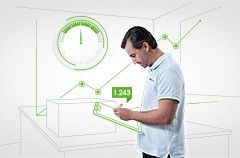Achieve trustworthy results such as composition, content, residue and stability with a Thermogravimetric Analyzer from the balance technology leader. ...
Achieve trustworthy results such as composition, content, residue and stability with a Thermogravimetric Analyzer from the balance technology leader. Experience the ultimate in ease-of-use thanks to experiment launch with One Click™, built-in mass flow controllers and automatic buoyancy compensation. A cleverly designed, factory endurance tested autosampler with single axis movement and flexible crucible handling provides efficient and reliable routine operation around the clock.
TGA
Thermogravimetric Analysis (TGA) is a technique that measures the change in weight of a sample as it is heated, cooled or held at constant temperature. Its main use is to characterize materials with regard to their composition. Application areas include plastics, elastomers and thermosets, mineral compounds and ceramics as well as a wide range of analyses in the chemical and pharmaceutical industries.
The heart of a Thermogravimetric Analysis system is the balance cell. Our TGA instruments use the world’s best METTLER TOLEDO micro and ultra-micro balances. The internal calibration ring weights ensure unsurpassed accuracy. You can also calibrate and adjust your balance with external weights.
No other TGA can measure up to 50 million resolution points continuously – weight changes of a 5-gram sample are determined to 0.1 µg. This means you can measure small and large samples with the same high resolution without having to change the weight range.
The parallel-guided balance ensures that the position of the sample does not influence the weight measurement. If the position of the sample changes during melting, no change in weight occurs.
The horizontal furnace design helps minimize possible turbulence caused by thermal buoyancy and the purge gas. The gastight cell can be evacuated and purged with a defined gas atmosphere. A controlled closed system with precisely defined conditions like this is essential to obtain unambiguous information and quality results.
All TGA versions can be connected online to a mass spectrometer, an FTIR spectrometer or a GC/MS system. Analysis of the gaseous decomposition products yields additional information about the sample. This enables you to interpret measurement curves with greater certainty.















